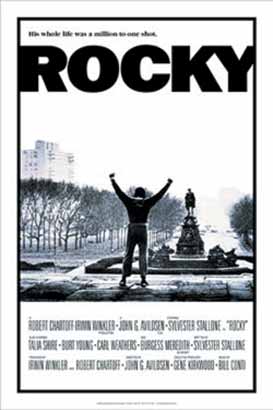Summary
The manner of Christ's death and his crucified posture are not incidental. This piece explores the purpose and meaning they hold.
|
|
Notes
Rocky & the Gospel
The film Rocky has similarities to the Christian story. Both are the stories about an underdog. After a hard fought fight, our hero is seemingly defeated. By all outward appearances he is conquered.
But, in the end, the decision against Rocky has no hold on him. "Adrian, Adrian," he calls out. He reunites with his beloved, victorious.
"But God raised [Jesus] up again, putting an end to the agony of death, since it was impossible for Him to be held in its power." (Acts 2:24) "Let us rejoice and be glad and give the glory to Him, for the marriage of the Lamb has come and His bride [the Church] has made herself ready." (Rev 19:7) From out of apparent defeat, triumph.

(Scripture taken from the NEW AMERICAN STANDARD BIBLE®, Copyright © 1960, 1962, 1963, 1968, 1971, 1972, 1973, 1975, 1977, 1995 by The Lockman Foundation. Used by permission.)
|
|
|
|

Christ Crucified
Could the Son of God have given his life any way other than he did on the cross? Could his self-sacrificial death been achieved in another place, at another time, in a different manner? With the benefit of hindsight, details of Jesus' atonement are clearly foretold of in the Old Testament. (For instance, read Psalm 22 or the "Servant of the Lord" passages in Isaiah, which clearly predict circumstances of Jesus' death on the cross.) God foresaw his plan for this world long in advance to Jesus' incarnation. But I suggest God chose the time and place of Jesus' coming for maximal effect. He perfectly chose the setting for his birth, youth, ministry, death, and resurrection.
The point is that Jesus' death by Roman crucifixion was not incidental. I suggest there are unique characteristics linked to that means of death which fit perfectly into God's plan. One could talk about the uniquely excruciating pain of crucifixion, or its exceeding humiliation (the condemned were naked). How crucifixion provided the opportunity for Jesus' true identity and "crime" to be posted above his thorn crowned head on the cross: "The King of the Jews". Or one could discuss how crucifixion allowed Jesus the opportunity to speak his last words amidst his worst suffering. But, the aspect to be discussed here is the meaningful posture crucifixion provided to Jesus for his atoning death.
Upon the cross, Jesus is lifted up. His elevated position suggests dominance and authority, but what he is enduring reveals him to be the servant of all. Bowing his head down, he looks upon people who love him and others who hate him. Raising his head up, he looks toward his Father. This is the posture of the Mediator on his cross.
What struck me, inspiring this entire train of thought, was the position of Jesus' arms on the cross. He has simultaneously the posture of victory and surrender. It is an action seen both of a champion in celebration and of a soldier who surrenders to an enemy. Good Friday may well be both the best and the worst day in human history. This convergence of victory and defeat is reflected by Jesus' posture on the cross.
Jesus' arms remind me of one who wants to draw another's attention and be seen, like one who waves down a passing car from the side of the road. Jesus also wants to draw our attention on the cross. And lastly, Jesus' position on the cross is as one who desires to embrace.
|
|
